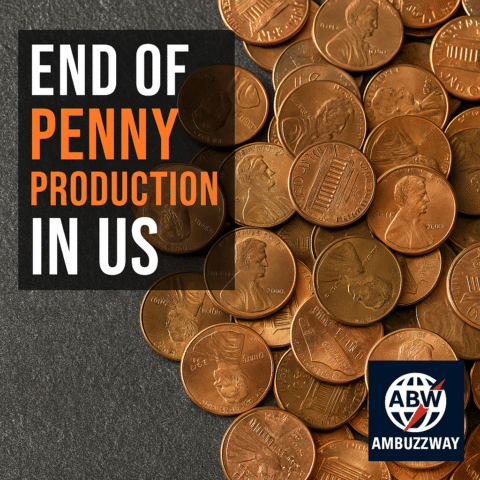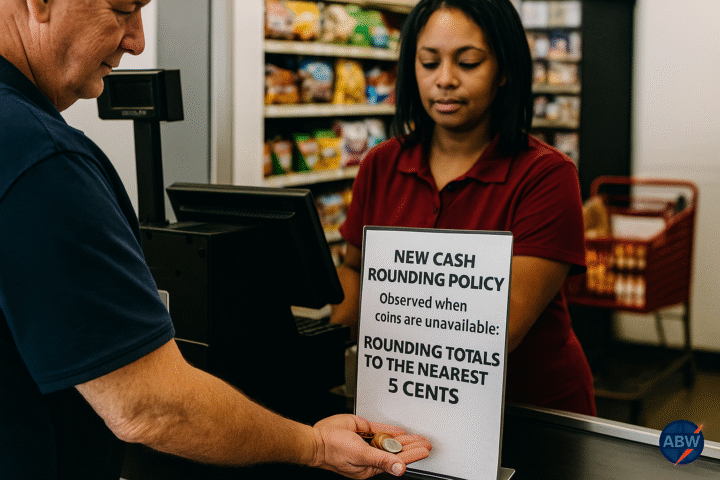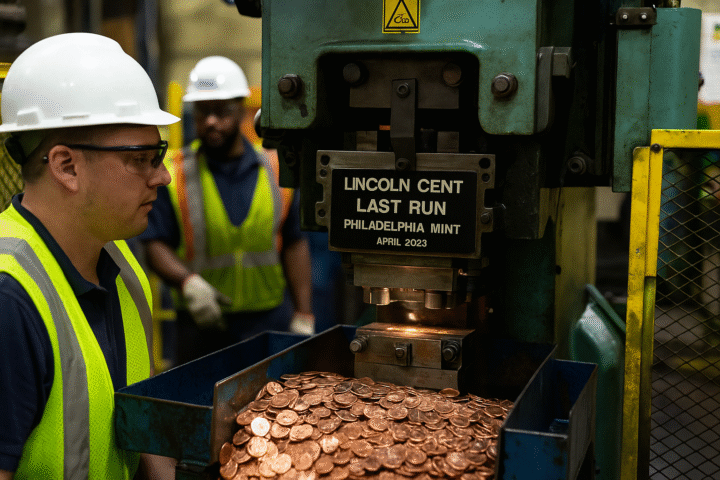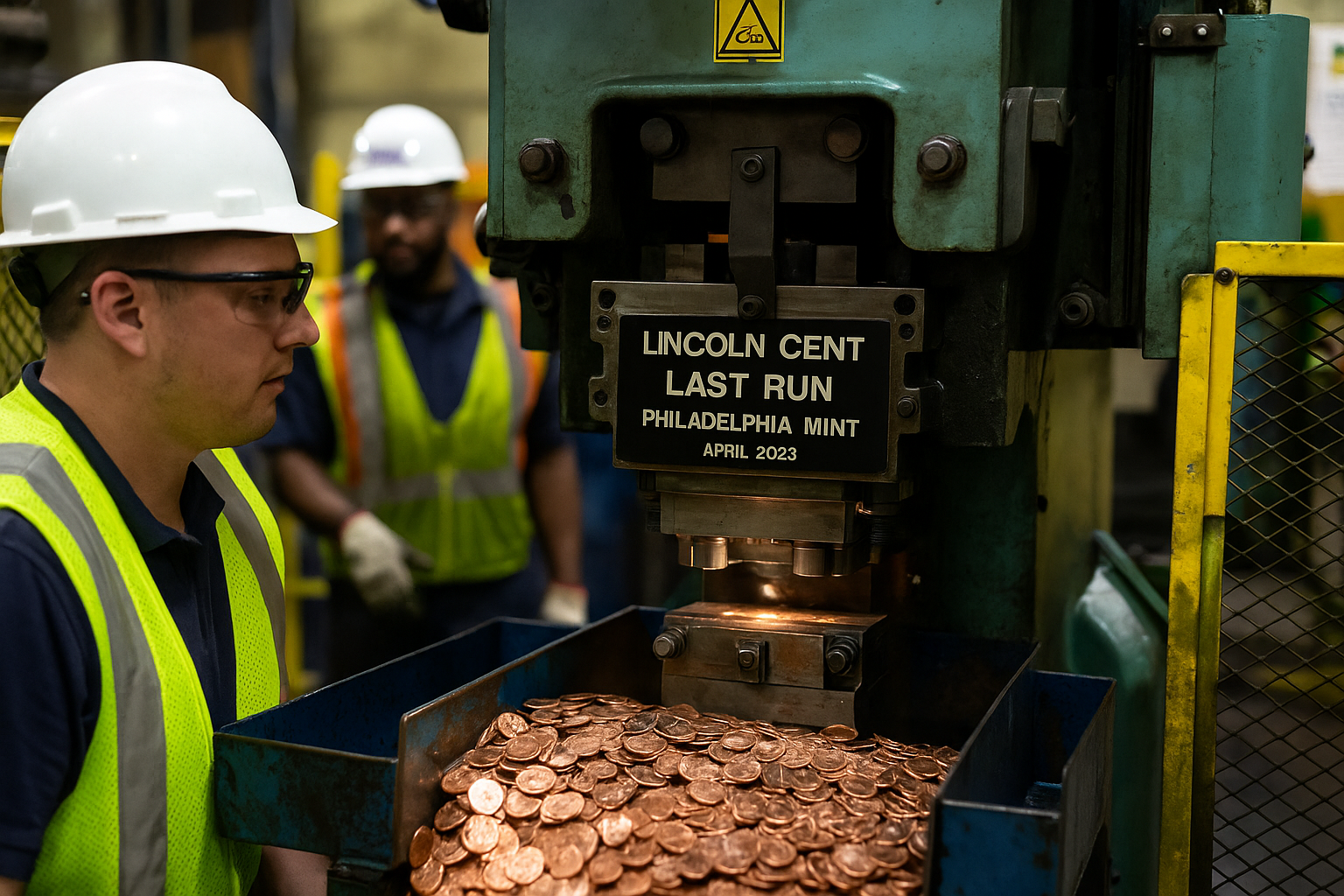US ends penny production—the United States is officially closing the book on the one-cent coin after more than two centuries in Americans’ pockets and piggy banks. The Philadelphia Mint is striking the final batch of circulating pennies, capping a 230-plus-year run that began in the early republic and evolved through countless designs, metals, and cultural meanings. The Treasury projects that stopping new pennies will save tens of millions of dollars annually, citing a simple, stubborn math problem: each one-cent piece has been costing nearly four cents to manufacture and distribute. Retailers are already pivoting, banks are adjusting coin-ordering routines, and consumers will soon see cash transactions rounded to the nearest five cents—while digital payments remain exact. AP News+2Reuters+2
A final day at the Mint—and the end of an era
In Philadelphia, dignitaries and Mint officials gathered as presses produced the last circulating pennies, a ceremonial but consequential milestone in U.S. monetary history. The one-cent coin debuted in 1793; Abraham Lincoln’s profile has graced the obverse since 1909, making it the longest-running portrait on American coinage. Today’s farewell underscores how quickly cash habits are changing in an era dominated by cards and phones. The penny is not being demonetized—existing coins remain legal tender—but the production line is stopping. AP News+1

Why the penny finally hit a wall: costs, convenience, and modern payments
The penny’s economics have been upside-down for years. According to the U.S. Mint’s most recent data, producing and distributing a single one-cent coin costs around 3.7 cents, thanks to metal prices, fabrication, and logistics. That negative margin—known as a seigniorage loss—adds up when the Mint strikes billions of pennies annually. Treasury officials and outside economists argue the country has been paying a premium for a coin with dwindling utility in everyday life, particularly as digital transactions displace cash. In 2024 alone, seigniorage losses attributed to the penny ran into the tens of millions. Federal Reserve Bank of Richmond
The math behind the decision
- Unit cost: ~3.7 cents to make and distribute a one-cent coin
- Annual savings: Treasury estimates around $56 million saved per year by ceasing penny production
- Share of coin flow: The penny has accounted for a large share of coins struck each year, compounding the loss
These figures have repeatedly sparked debates in Congress and across administrations; in recent months they coalesced into definitive action: the presses would stop. Reuters+1
What happens at the register: rounding rules, in practice
Ending production doesn’t mean pennies vanish. They’ll remain in circulation for years, gradually attriting as coins are lost, stashed, or redeemed. But as supplies tighten and banks stop re-ordering fresh pennies, more retailers are expected to adopt rounding on cash transactions (card and mobile payments can remain exact). If your total ends in 1–2 cents, it rounds down to $0.00; 3–4 cents to $0.05; 6–7 to $0.05; and 8–9 to $0.10. Studies of countries that dropped low-denomination coins—and a recent Richmond Fed analysis modeling U.S. behavior—suggest the average consumer effect is small, though not perfectly symmetrical. One estimate pegs the annual consumer impact of rounding at roughly $6 million nationwide—modest in the context of the overall economy, but meaningful enough to be noticed in policy debates. Federal Reserve Bank of Richmond
Will rounding raise prices?
Evidence from Canada, New Zealand, Australia, and others shows that transparent rounding policies can be implemented without systematic overcharging—especially when competition and consumer scrutiny are strong. Retailers typically round each transaction, not each item, which dampens any bias. U.S. consumers can expect to see signs at registers explaining the policy, while receipts will continue to show precise, pre-rounding subtotals and taxes. In all cases, electronic transactions (debit, credit, mobile wallets) should remain exact, so anyone who prefers exact cents can avoid rounding entirely by paying digitally. AP News
“US ends penny production”—what this means for households
Most households already have small reserves of coins sitting in jars, trays, and drawers—often never redeemed. By one government estimate in recent years, a significant share of circulating coins sit idle at home rather than moving through registers and bank branches. The penny, in particular, tends to fall out of circulation fastest; people are less inclined to spend or roll them. The phase-out nudges those lost pennies into clarity: if you find old rolls or a pile on the dresser, it’s still spendable or depositable. Banks and coin machines will continue to accept them for the foreseeable future. AP News

Practical tips for consumers
- Bring in your jars: Coin kiosks and banks can convert mixed change to cash or deposits.
- Use digital if you want exact cents: Paying by card or phone avoids rounding.
- Keep a small stash for vending and parking (for now): Some machines may still accept pennies; over time, most won’t rely on them.
- Watch posted policies: Stores should disclose rounding practices at the register.
Retailers, restaurants, and small businesses: how to adapt
The penny’s exit arrives amid already tight coin supplies in some areas (remember the “coin circulation” slowdowns during the pandemic). Retailers who’ve been rationing rolls or running short at day’s end may find the transition simplifies cash handling. But it also requires clear communication with staff and customers, updated POS settings, and signage explaining rounding.
Five operational steps for a smooth transition
- Update POS software to automatically apply per-transaction rounding on cash sales.
- Retrain staff on cash-drawer procedures, rounding policy, and customer questions.
- Post clear signage at the door, counter, and terminal: “Cash totals rounded to nearest $0.05.”
- Audit price endings on popular items. If your brand uses .99 pricing, consider whether .95 or .90 makes more sense visually.
- Monitor receipts and refunds to ensure returns mirror the original payment method and rounding (use exact cents if refunding to card).
Will small businesses lose out?
Margin-wise, rounding should net out across many transactions. Remember: rounding happens on the final total, not every line item. Over time, you’ll likely see a mix of round-ups and round-downs. Digital payments sidestep the issue entirely. For cash-heavy micro-businesses, the main change is logistics: fewer low-value coins to order, store, and count.

The history that brought us here
The United States has reinvented its coins repeatedly. The penny is a case study in adaptation: early large cents were pure copper, later compositions toggled with wars and commodity prices, and today’s circulation cents are copper-plated zinc. The Lincoln cent—first issued for the president’s centennial in 1909—became a cultural staple, its memorial reverse (1959–2008) and later shield reverse (from 2010) instantly recognizable. That ubiquity is exactly why the farewell resonates beyond accounting ledgers: people grew up hunting “wheaties,” mashing pennies into souvenir ovals at national parks, or tossing them into fountains for luck.
Design, metals, and the cost puzzle
As copper prices rose and the Mint sought durable, machinable alternatives, composition tweaks helped—but only to a point. The real-world costs of planning, striking, distributing, and recirculating mountains of tiny coins have increasingly outweighed their value. Even aggressive cost management couldn’t reverse the basic problem: a one-cent unit in a 21st-century economy doesn’t buy enough to justify its production costs. Treasury officials have wrestled with this calculus across multiple administrations before today’s stop. Federal Reserve Bank of Richmond
How other countries retired their lowest coins—and what we can learn
- Canada (2012) stopped making its one-cent coin and adopted rounding on cash totals. The rollout was accompanied by clear government and retailer guidance and public-facing educational campaigns.
- Australia and New Zealand (1990s) retired one- and two-cent coins, and later (in NZ) the five-cent piece as well.
- United Kingdom floated dropping the 1p in 2018; the idea was shelved, but production pauses and restarts have reflected changing demand and inventory levels.
In each case, public communication, consistent rounding rules, and retailer readiness smoothed the shift. The United States is now following a similar script. AP News
Will charities be hurt if pennies disappear?
Penny drives are iconic, but most charities now rely on digital channels capable of capturing small amounts at scale—tap-to-give, roundup features, and monthly micro-donations. Many school and community coin drives have shifted to mixed-coin or dollar-bill formats anyway. As with retailers, clear messaging helps: “Round up to donate” at the register can replace or even surpass the occasional handful of cents in a jar.
Banking and cash logistics in a post-penny world
Banks and armored-car carriers will rebalance demand forecasting. The penny occupied physical space and labor in vaults and branches. Over time, less volume in low-denomination coin means fewer replenishment runs and less handling. Expect banks to continue redeeming pennies indefinitely, but they’ll stop ordering fresh supplies. Financial institutions will update coin-ordering portals with rounding guidance for retail clients and accelerate the push toward contactless payments in small-ticket environments.

Inflation myths, price psychology, and the .99 ending
Some argue the penny’s demise will fuel inflation. But a coin’s existence doesn’t anchor price levels; monetary policy and macroeconomic forces do. Rounding applies only to cash totals and is as likely to round down as up. If anything, the bigger shift to watch is price-ending psychology. American retailers have leaned on .99 endings for decades; they convey value at a glance. Without pennies, some merchants will experiment with .95 or .90 to keep that same “feel” while aligning with the five-cent grid. Others will keep .99 tags and simply let cash totals round—a fine approach so long as signage and receipts are clear.
What about the nickel?
Killing the penny doesn’t erase another thorn in the Mint’s side: the nickel currently costs nearly 14 cents to produce, according to recent estimates. That mismatch is even more dramatic than the penny’s, but the nickel plays a larger role in cash pricing increments. Modeling by researchers suggests eliminating the nickel would have a much bigger cash-rounding footprint, with consumer effects an order of magnitude larger than the penny’s. For now, policymakers have trained their focus on the smallest coin and the biggest, easiest savings. The nickel debate will continue, but it’s not part of today’s action. AP News
US ends penny production: how we got the green light
Today’s final-strike ceremony follows a policy arc that included formal analysis by Treasury and the Mint, public commentary, retailer feedback, and an executive directive to end penny minting. Law and tradition give Congress and the executive branch authority over coinage; aligning that authority with the practical realities of 2025’s payment landscape produced a clear decision. The press will stop; existing coins will remain legal tender; and the government will book recurring savings each year the presses stay idle. Reuters
Key milestones at a glance
- 1793: First U.S. one-cent coins debut.
- 1909: Lincoln cent introduced.
- 2010: Modern “Union Shield” reverse introduced for the cent.
- 2024–2025: Formal cost and policy analyses converge; directive issued to end penny minting; final run scheduled at Philadelphia.
- Today: The Philadelphia Mint strikes the last circulating pennies; rounding guidance spreads nationwide. AP News+1
For collectors: what becomes a keepsake?
Ending production often sparks a brief rush for proof sets, mint rolls, and error coins. While ordinary pennies won’t suddenly gain value, special finishes and low-mintage issues can. The Mint’s collector programs may offer limited editions—already hinted at by officials—to satisfy demand from numismatists marking the transition. As always, condition, rarity, and provenance drive collectible value. If you’re curious, consult the Mint’s catalog or trusted dealer guides and treat today’s rolls more as souvenirs than investments. Reuters
Government, retailers, and you: a shared to-do list
- Government/Treasury: Publish consistent national rounding guidance; coordinate with states on sales-tax calculation where relevant; maintain public FAQs; support accessibility for cash-reliant communities.
- Retailers: Update POS, train staff, post clear signage, test receipt accuracy, and ensure refunds mirror original payment methods.
- Consumers: Choose digital for exact cents; expect cash totals to round; bring idle coin jars into circulation or deposit them.

Frequently asked questions
Are pennies still legal to use?
Yes. Pennies already in circulation remain legal tender; no one is required to accept them in every context (private businesses set their own cash policies), but banks and coin machines will continue handling them for the foreseeable future. AP News
Will sales tax be rounded too?
Typically, tax is calculated precisely first; rounding then applies to the final cash total. States and municipalities that administer sales tax will issue guidance that dovetails with retailers’ rounding policies. AP News
Can I avoid rounding?
Yes. Pay by card or phone and your total will be charged to the exact cent. Rounding only affects cash transactions. AP News
Is this about going “cashless”?
No. Cash remains legal. This is about not manufacturing a coin that costs more to make than it’s worth. Plenty of countries keep cash while dropping tiny denominations. AP News
Why not change the penny’s metal?
The Mint has tested alternative alloys and incremental efficiencies for years. Even with changes, the economics remain unfavorable when all-in costs are counted, especially at 2020s metal prices and labor/logistics costs. Federal Reserve Bank of Richmond
Will the government really save money?
Yes—ending penny production removes an annual seigniorage drag and related distribution costs. Treasury and independent analyses put savings around $56 million per year—money that can be reallocated elsewhere. Reuters+1
US ends penny production: the cultural afterglow
No object this small has carried so much symbolic weight. We teach kids to count with pennies; “a penny for your thoughts” lives in our language; lucky pennies are tucked into wedding shoes. That symbolism doesn’t vanish with the presses’ shutdown—if anything, today’s shift may make the remaining pennies in your junk drawer feel more like artifacts than annoyances. Museums will collect representative strikes; numismatists will debate key dates and varieties; the rest of us will glance at a copper-colored coin and remember the time it mattered that something cost exactly 99 cents.
What to watch next
- Retail rollout of rounding: Expect a staggered, region-by-region adoption as stores update systems.
- Bank guidance: Branches may run penny-collection promotions to recirculate stranded change into nickels, dimes, and quarters.
- The nickel conversation: Policymakers will keep one eye on that 14-cent unit cost, but any move there would require a more complex impact analysis. AP News
Bottom line
The headline US ends penny production marks a pragmatic decision rooted in arithmetic and modern behavior. It saves real public money, trims a logistical burden, and acknowledges what the past decade has made obvious: most transactions have outgrown the need for a one-cent coin. For everyday life, not much changes: cash totals will round fairly, digital remains exact, and your old pennies still spend. The last batch rolling off the Philadelphia presses is both an ending and a nod to a national habit we’re finally ready to retire. AP News+1
External sources (for reference)
- Reuters – “U.S. treasurer to strike final penny at Philadelphia Mint” (Nov. 12, 2025). Reuters
- Associated Press – “U.S. Mint in Philadelphia struck its final 1-cent coin” (Nov. 12, 2025). AP News
- Axios – “The last-ever penny is being minted today in Philadelphia” (Nov. 12, 2025). Axios
- Federal Reserve Bank of Richmond – “Rounding Up: The Impact of Phasing Out the Penny” (2025). Federal Reserve Bank of Richmond


